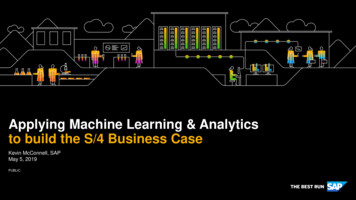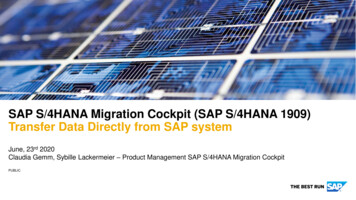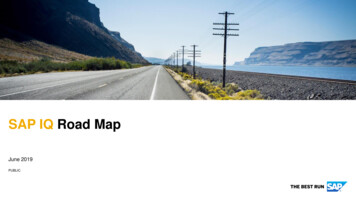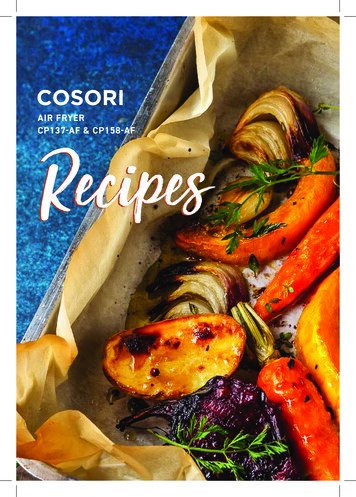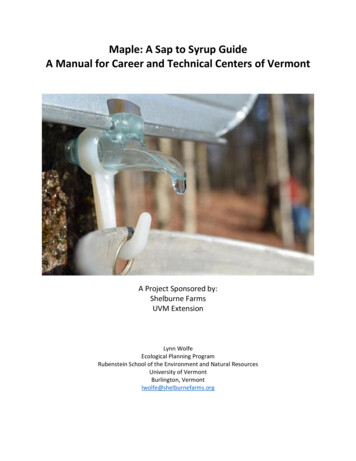
Transcription
Maple: A Sap to Syrup GuideA Manual for Career and Technical Centers of VermontA Project Sponsored by:Shelburne FarmsUVM ExtensionLynn WolfeEcological Planning ProgramRubenstein School of the Environment and Natural ResourcesUniversity of VermontBurlington, Vermontlwolfe@shelburnefarms.org
AcknowledgementsThis project was made possible with the support and contributions of many people. Through generousfunding provided by Shelburne Farms and UVM Extension, the idea of completing a masters project onthe topic of maple syrup production education became possible. Thank you to Mark Isselhardt, UVMExtension Maple Specialist, who provided invaluable guidance, amazing photographs, and deepened myknowledge and appreciation of the maple syrup industry. In addition, thank you to Shelburne Farms’staff members Dana Hudson who served as my project sponsor advisor, Megan Camp who helpedtransform the concept of a FNEP project into reality, Dana Bishop who taught me how to be asugarmaker, and Josh Carter whose flexibility allowed me to pivot my work focus from vegetables tomaple syrup.From the University of Vermont, my advisor, Walter Poleman, whose deep words of wisdom, calmingpresence, and guidance helped me overcome unforeseen obstacles. My graduate studies committeemembers, Anthony D’Amato and Simon Jorgenson helped narrow my objectives and offered support as Icarried out this project. I am also grateful for the incredible instructors and students involved in theFNEP program.Vermont Career and Technical Center educators Mark Wilde, Aaron Townshend, Josh Goss, Max VanHouten, Mark Raishart, Chris Masson, Jerry Leonard, Ben Nottermann, Peter Falby, Andrew Shatzer, andmore were interviewed, provided feedback, and/or participated in the Maple Career DevelopmentEvent (CDE). A wonderful team of volunteers made the Maple CDE run smoothly. Thank you to LizKenton, David Lalanne, Cyrus Grennon, George Cook, and Marshall Webb for lending your expertise tomake the event successful. The event would not have been possible without the generosity of mapleindustry representatives that donated tools, materials, prizes, and their time to assist with thedevelopment and execution of the event. Donors include: CDL USA, H2O Innovations, Lapierre USA, andLeader Evaporator, Mike Rechlin, VT Maple Sugar Makers’ Association, and Hillsboro Sugarworks.My wife, Mary Claire Walsh, who’s never-ending support, proofreading skills, Latin flashcard rhymes,solo weekends with two kids under the age of three, and positive attitude allowed me to complete theEcological Planning Program and kept me somewhat sane. Her support of my academic and professionaldevelopment is a gift whose value is beyond measure. Finally, my children, Anya and Alden Wolfe, whowere both born during my graduate school career. While Alden is too young, Anya has appreciated afierce love for all things maple and has spent many happy hours in the sugarhouse.i
Table of ContentsIntroduction . 1Maple identification . 1Characteristics of maple stands . 5Species associations . 5Site factors . 5Tree physiology . 6Photosynthesis . 6Understanding maple trees . 7Sap flow mechanism . 8Factors influencing sap flow . 10Sugarbush management techniques . 10Stand structure . 11Management plan . 11Stocking conditions . 12Tree selection. 13Crop tree release. 14Biodiversity . 16Wildlife . 16Bird-friendly sugarbush management . 17Problems that affect sugarbush health and regeneration. 17Insects and animals . 18Diseases. 22Plants. 23Tapping. 25When to tap . 25Tapable trees . 25Tapping Guidelines. 26Tapping equipment . 28Where to tap . 29Drilling the hole. 31Seating the spout . 31. 31ii
. 31Sap collection . 32Gravity sap collection . 32Tubing . 33Design of tubing systems . 35Mainline . 35Lateral lines . 38. 39Connecting lateral line to mainline . 39Installing droplines . 403/16 tubing. 41Checking for leaks . 42Cleaning tubing . 43Vacuum . 43Sap releasers/extractors . 45Sap storage. 45Evaporator . 46The gradient . 48Reverse osmosis . 48Operating the evaporator . 50Hydrometer . 51Refractometer . 54Filtering syrup . 54Gravity filters. 55Pressure filters . 55Shutting down evaporator . 56Cleaning evaporator. 56Vermont sugar house certification program . 57Jones Rule of 86 or is it 88.2?. 57Syrup grading . 58Bottling syrup . 62Record keeping . 63Value-added products. 63Organic certification. 66Marketing and business planning . 66iii
Changing climate. 72Appendix A: Bird-Friendly Maple Project Management Guidelines . 75Appendix B: Bird-Friendly Sugarbush Assessment . 77Appendix C: Tools and Materials Photo Guide . 80Appendix D: Sugaring Operations Certification Score Sheet . 84Appendix E: Maple Syrup Grading Flow Sheet . 92Appendix F: Record Keeping . 93Glossary . 96References . 102iv
Figure 1 - Opposite vs alternate branching. 1Figure 2 - Sugar maple identification and range . 2Figure 3 - Red maple identification and range. 3Figure 4 - Red maple and sugar maple bud comparison . 4Figure 5 - Photosynthesis . 6Figure 6 - Anatomy of a tree . 7Figure 7 - Xylem in a hardwood tree. 7Figure 8 - How sap flows . 9Figure 9 - Structures of even-aged and uneven-aged sugarbush . 11Figure 10 - Stocking chart . 12Figure 11 - Crop tree release . 14Figure 12 - Pileated woodpecker utilizing cavity tree . 16Figure 13 - Comparison between Asian Longhorned Beetle and Whitespotted Pine Sawyer . 18Figure 14 - Emerald ash borer. 19Figure 15 - Defoliation of maple tree caused by forest tent caterpillar . 20Figure 16 - Maple leaf cutter . 21Figure 17 - Squirrel damage . 21Figure 18 - Invasive worms effect on forest understory . 22Figure 19 - Eutypella canker. 22Figure 20 - Nectria canker . 23Figure 21 - Common buckthorn . 23Figure 22 - Invasive Shrubs . 24Figure 23 - Beech thicket . 24Figure 24 - Relationship between tree diameter and syrup yield (lbs) . 26Figure 25 - Taphole scar . 27Figure 26 - Drill and bit. 28Figure 27 - Spouts . 28Figure 28 - Cross section of a tapped maple tree . 29Figure 29 - Identifying previous tapholes . 30Figure 30 - Taphole . 31Figure 31 - Properly seated spout . 31Figure 32 - Seating the spout . 31Figure 33 - Image of traditional galvanized sap buckets . 32Figure 34 - Tubing terminology . 34Figure 35 - View of mainline pitch through sight level . 35Figure 36 - Encasing wire to prevent damage to tree. 36Figure 37 - Installation of a mainline . 37Figure 38 - Connecting support wire to mainline . 37Figure 39 - Securing lateral line . 38Figure 40 - Hooked slide fitting . 38Figure 41 - Two-handed tubing tool . 38Figure 42 - Connecting fittings to lateral line. 39Figure 43 - Connection between lateral line and mainline . 39Figure 44 - Making a dropline . 40Figure 45 - Dropline . 40Figure 46 - Visual comparison of 5/16” and 3/16” tubing . 41Figure 47 - Air bubbles in tubing . 42Figure 48 - Relationship between vacuum and sap yield . 43v
Figure 49 - Components of a vacuum pump. 44Figure 50 - Sap transferring from releaser to collection tank . 45Figure 51 - Evaporator . 46Figure 52 - Styles of flue pans . 47Figure 53 - Diagram of sugar concentration gradient in evaporator . 48Figure 54 - Reverse osmosis semi-permeable membrane. 49Figure 55 - Reverse osmosis machine . 49Figure 56 - Niter . 51Figure 57 - Drawing off finished syrup from the evaporator . 51Figure 58 – Hydrometer . 52Figure 59 - Reading a hydrometer . 53Figure 60 - Using a hydrometer . 53Figure 61 - Reading a refractometer . 54Figure 62 - Flat gravity filter . 55Figure 63 - Clear filter press . 56Figure 64 - Components of a plate filter press . 56Figure 65 - Maple syrup grades. 58Figure 66 - When using comparator kits make sure you are in an area that well illuminated with direct,natural light. . 59Figure 67 - Impact of using an old temporary grading kit . 59Figure 68 - Filtered vs. unfiltered syrup . 60Figure 69 - Grading maple flavor . 60Figure 70 - UVM Extension off-flavor syrup reference kit . 61Figure 71 - Syrup canner . 62Figure 72 - Maple candy. 65Figure 73 - Maple lollipops. 65Figure 74 - Bulk maple syrup prices . 71Figure 75 - Snow covering high elevation in early spring . 73Table 1 - Characteristics of commercially tapped maple trees. 4Table 2 - Traditional tapping guidelines. 27Table 3 - Conservative tapping guidelines . 27Table 4 - Organic tapping guidelines. 27Table 5 - Recommended number of taps for mainlines of different diameter on different slopes . 36Table 6 - Temperature conversion chart for maple syrup hydrometer . 52Table 7 - Capital start-up costs . 67Table 8 - Sales forecast for a 2,500 tap maple syrup business . 68Table 9 - Retail maple syrup prices . 72vi
IntroductionMaple syrup production is a very important aspect of Vermont life and history. Every year in the earlyspring people of all ages find their way to the woods to tap trees, collect sap, and participate in the greattradition of producing maple syrup. Vermont is the largest maple syrup producer in the United Statesand maple is an essential industry from a historical, cultural, agricultural, and economic perspective. Asthe industry continues to grow, it creates potential employment opportunities for people of all ages,including recent high school graduates.This manual was developed primarily for use by Vermont Career and Technical Center educators andstudents. It can be used as a reference as students learn about aspects of sugarbush management andsyrup production. Biology, chemistry, math, history, and the culture of maple syrup making can enrichthe educational experience as well as provide technical skills for students interested in working in themaple industry. The overall goal of the manual is to create consistency in the sugaring techniques thatare taught throughout Vermont and as a guide to prepare students for the Vermont Maple CareerDevelopment Event. This manual can also be a valuable resource for anyone interested in sugaring, fromthe back-yard sugar maker to a new employee joining an established maple syrup producer.This manual highlights the core principals to training good sugarmakers, both from a production andquality perspective. Key concepts include: Tree characteristics (tree size, health, genetics) Environmental factors and change (weather, invasive species, climate change) Tapping practices (timing of tapping, placement, depth) Tubing (installation, repair, cleaning procedures) Vacuum (relationship between vacuum and sap yield, vacuum level)All of these concepts are interrelated and important to syrup production.Maple identificationIf you are going to make maple syrup the first thing you need to know is how to identify a maple tree.The easiest way to identify maple trees is before the leaves fall. However, it is still possible to identifymaple species even after they have lost their leaves. To do this look at the branching and leaf scarpatterns. Leaf scars are where the leaves of the past summer were attached to the branch. The scars arevisible after the leaves have fallen. An opposite pattern is where the branches and leaves (or leaf scars ifthe leaves have alreadydropped) grow from thebranch directly oppositeeach other, like a “T”.Maple, ash, dogwood, andhorse chestnut are theonly native NorthAmerican deciduous treesthat have oppositebranching. All others havealternate branchingFigure 1 - Opposite vs alternate branchingpatterns (Rechlin, 2015).Plantswithoppositebranchingpattern, like maple, have pairs of buds or leaves at eachThere are many differentnode. Plants with alternate branching pattern have only one bud or leaf at each node.species of maple(Image source Dinnan, 2012)including silver maple1
(Acer saccharinum), black maple (Acer nigrum), Norway maple (Acer platanoides), and box elder (Acernegundo). All maples can be tapped, but for the purpose of this manual we will focus on the two maplespecies that a
FNEP program. Vermont Career and Technical Center educators Mark Wilde, Aaron Townshend, Josh Goss, Max Van Houten, Mark Raishart, Chris Masson, Jerry Leonard, Ben Nottermann, Peter Falby, Andrew Shatzer, and more were interviewed, provided feedback, and/or participated in the Maple Career Development Event (CDE).




